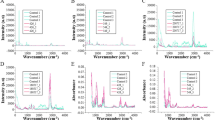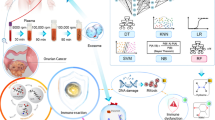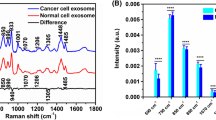Abstract
Patient-derived extracellular vesicles (EVs) that contains a complex biological cargo is a valuable source of liquid-biopsy diagnostics to aid in early detection, cancer screening, and precision nanotherapeutics. In this study, we predicted that coupling cancer patient blood-derived EVs to time-resolved spectroscopy and artificial intelligence (AI) could provide a robust cancer screening and follow-up tools. In our pilot study, fluorescence correlation spectroscopy (FCS) measurements were taken on 24 blood samples-derived EVs. Blood samples were obtained from 15 cancer patients (presenting five different types of cancers), and nine healthy controls (including patients with benign lesions). EVs samples were labeled with PKH67 dye. The obtained FCS autocorrelation spectra were processed into power spectra using the fast Fourier transform algorithm. The processed power spectra were subjected to various machine learning algorithms to distinguish cancer spectra from healthy control spectra. The performance of AdaBoost Random Forest (RF) classifier, support vector machine, and multilayer perceptron were tested on selected frequencies in the N = 118 power spectra. The RF classifier exhibited the highest classification accuracy and performance metrics in distinguishing the FCS power spectra of cancer patients from those of healthy controls. Further, neural computing via an image convolutional neural network (CNN), ResNet network, and a quantum CNN were assessed on the power spectral images as additional validation tools. All image-based CNNs exhibited a nearly equal classification performance and reasonably high sensitivity and specificity scores. Our pilot study demonstrates that AI-algorithms coupled to time-resolved FCS power spectra can accurately and differentially classify the complex patient-derived EVs from different cancer samples of distinct tissue subtypes. As such, our findings hold promise in the diagnostic and prognostic screening in clinical medicine.





Similar content being viewed by others
Explore related subjects
Discover the latest articles, news and stories from top researchers in related subjects.Data and code availability
All codes and sample datasets obtained in this experiment are made available in the GitHub link below. GitHub link: https://github.com/Abicumaran/FCS_EVClassification. Multifractal analysis: WTMM toolbox guidelines in MATLAB to extract Hurst scaling exponent: https://www.mathworks.com/help/wavelet/ug/multifractal-analysis.html. https://onlineconfusionmatrix.com/ (to calculate the sensitivity and specificity from the confusion matrices).
References
Gold P, Freedman S (1965) Demonstration of tumor-specific antigens in human colonic carcinomata by immunological tolerance and absorption techniques. J Exp Med 121(3):439–462. https://doi.org/10.1084/jem.121.3.439
Zhou B, Xu K, Zheng X et al (2020) Application of exosomes as liquid biopsy in clinical diagnosis. Sig Transduct Target Ther 5:144. https://doi.org/10.1038/s41392-020-00258-9
Alix-Panabières C, Pantel K (2013) Circulating tumor cells: liquid biopsy of cancer. Clin Chem 59(1):110–118. https://doi.org/10.1373/clinchem.2012.194258
Han X, Wang J, Sun Y (2017) Circulating tumor DNA as biomarkers for cancer detection. Genomics Proteomics Bioinformatics 15(2):59–72. https://doi.org/10.1016/j.gpb.2016.12.004
Bronkhorst AJ, Ungerer V, Holdenrieder S (2019) The emerging role of cell-free DNA as a molecular marker for cancer management. Biomol Detect Quant 17:100087. https://doi.org/10.1016/j.bdq.2019.100087
Sui J, Wu X, Wang C et al (2021) Discovery and validation of methylation signatures in blood-based circulating tumor cell-free DNA in early detection of colorectal carcinoma: a case–control study. Clin Epigenet 13:26. https://doi.org/10.1186/s13148-020-00985-4
Zhao Z, Fan J, Hsu Y-M, Lyon CJ, Ning B, Hu TY (2019) Extracellular vesicles as cancer liquid biopsies: from discovery, validation, to clinical application. Lab Chip 19(7):1114–1140. https://doi.org/10.1039/c8lc01123k
Johnstone RM (2005) Revisiting the road to the discovery of exosomes. Blood Cells Mol Dis 34(3):214–219. https://doi.org/10.1016/j.bcmd.2005.03.002
Pan B-T, Johnstone RM (1983) Fate of the transferrin receptor during maturation of sheep reticulocytes in vitro: selective externalization of the receptor. Cell 33:967–976
Pan B-T, Teng K, Wu C, Adam M, Johnstone RM (1985) Electron microscopic evidence for externalization of the transferrin receptor in vesicular form in sheep reticulocytes. J Cell Biol 101:943–948
Szatanek R, Baj-Krzyworzeka M, Zimoch J, Lekka M, Siedlar M, Baran J (2017) The methods of choice for extracellular vesicles (EVs) characterization. Int J Mol Sci 18:1153. https://doi.org/10.3390/ijms18061153
Abdouh M, Zhou S, Arena V, Arena M, Lazaris A, Onerheim R, Metrakos P, Arena GO (2014) Transfer of malignant trait to immortalized human cells following exposure to human cancer serum. J Exp Clin Cancer Res 33:86
Abdouh M, Hamam D, Arena V, Arena M, Alamri H, Arena GO (2016) Novel blood test to predict neoplastic activity in healthy patients and metastatic recurrence after primary tumor resection. J Circ Biomark. https://doi.org/10.1177/1849454416663661
Abdouh M, Tsering T, Burnier JV, de Alba Graue PG, Arena G, Burnier MN (2020) Horizontal transfer of malignant traits via blood-derived extracellular vesicles of uveal melanoma patients. Invest Ophthalmol Vis Sci 61(7):2835
Arena GO, Arena V, Arena M, Abdouh M (2017) Transfer of malignant traits as opposed to migration of cells: a novel concept to explain metastatic disease. Med Hypotheses 100:82–86
Zhou S et al (2017) Reprogramming malignant cancer cells toward a benign phenotype following exposure to human embryonic stem cell microenvironment. PLoS ONE 12(1):e0169899
Su C, Zhang J, Yarden Y et al (2021) The key roles of cancer stem cell-derived extracellular vesicles. Sig Transduct Target Ther 6:109. https://doi.org/10.1038/s41392-021-00499-2
Fu X, Song Y, Masud A, Nuti K, DeRouchey JE, Richards CI (2020) High-throughput fluorescence correlation spectroscopy enables analysis of surface components of cell-derived vesicles. Anal Bioanal Chem 412(11):2589–2597. https://doi.org/10.1007/s00216-020-02485-z
Uthamacumaran A, Elouatik S, Abdouh M et al (2022) Machine learning characterization of cancer patients-derived extracellular vesicles using vibrational spectroscopies: results from a pilot study. Appl Intell. https://doi.org/10.1007/s10489-022-03203-1
Shin H, Oh S, Hong S, Kang M, Kang D, Ji YG, Choi BH, Kang KW, Jeong H, Park Y, Hong S, Kim HK, Choi Y (2020) Early-stage lung cancer diagnosis by deep learning-based spectroscopic analysis of circulating exosomes. ACS Nano 14(5):5435–5444. https://doi.org/10.1021/acsnano.9b09119
Park J et al (2017) Exosome classification by Pattern analysis of surface-enhanced Raman spectroscopy data for lung cancer. Anal Chem 89(12):6695–6701
Shin H et al (2018) Correlation between Cancerous Exosomes and Protein Markers Based on Surface- Enhanced Raman Spectroscopy (SERS) and Principal Component Analysis (PCA). ACS Sensors 3(12):2637–2643
Ries J, Schwille P (2001) Fluorescence correlation spectroscopy. Springer series in chemical physics, vol. 65. https://doi.org/10.1007/978-3-642-59542-4
Thompson NL (2002) Fluorescence correlation spectroscopy. In: Lakowicz JR (eds) Topics in fluorescence spectroscopy, vol 1. Springer, Boston. https://doi.org/10.1007/0-306-47057-8_6
Elson EL, Magde D (1974) Fluorescence correlation spectroscopy. I. Conceptual basis and theory. Biopolym: Orig Res Biomol 13(1):1–27. https://doi.org/10.1002/bip.1974.360130102
Corso G, Heusermann W, Trojer D, Görgens A, Steib E, Voshol J, Graff A, Genoud C, Lee Y, Hean J, Nordin JZ, Wiklander O, El Andaloussi S, Meisner-Kober N (2019) Systematic characterization of extracellular vesicle sorting domains and quantification at the single molecule—single vesicle level by fluorescence correlation spectroscopy and single particle imaging. J Extracell Vesicles 8(1):1663043. https://doi.org/10.1080/20013078.2019.1663043
Wyss R, Grasso L, Wolf C, Grosse W, Demurtas D, Vogel H (2014) Molecular and dimensional profiling of highly purified extracellular vesicles by fluorescence fluctuation spectroscopy. Anal Chem 86(15):7229–7233. https://doi.org/10.1021/ac501801m
Pedregosa F et al (2011) Scikit-learn: machine learning in python. JMLR 12:2825–2830
Sengupta K, Srivastava PR (2021) Quantum algorithm for quicker clinical prognostic analysis: an application and experimental study using CT scan images of COVID-19 patients. BMC Med Inform Decis Mak 21:227. https://doi.org/10.1186/s12911-021-01588-6
Fedyuk V, Erez N, Furth N, Beresh O, Andreishcheva E, Shinde A, Jones D, Zakai BB, Mavor Y, Peretz T, Hubert A (2022) Multiplexed single-molecule epigenetic analysis of plasma-isolated nucleosomes for cancer diagnostics. Biorxiv. https://doi.org/10.1101/2021.11.01.466724v2.full
Maass W et al (2002) Real-time computing without stable states: a new framework for neural computation based on perturbations. Neural Comput 14:2531–2560
Verstraeten D et al (2007) An experimental unification of reservoir computing methods. Neural Netw 20:391–403
Acknowledgements
We are grateful to Ayat Salman for her assistance with the Ethical Committee approvals. Fluorescence correlation spectroscopy measurements were taken by Joel Ryan at the McGill Advanced BioImaging Facility (ABIF, RRID: SCR_017697).
Funding
This work was financially supported by Giuseppe Monticciolo and the Morris and Bella Fainman Family Foundation. The funders had no role in study design, data collection and analysis, decision to publish, or preparation of the manuscript.
Author information
Authors and Affiliations
Corresponding authors
Ethics declarations
Conflict of interest
The authors declare no conflict of interest.
Ethical approval
Patients were recruited in accordance with an approved ethics protocols by the Ethics Committee of the McGill University Health Centre (MP-37-2018-3916 and SDR-10-057). Patients signed consents were obtained before enrollment in the study.
Preprint
An earlier version of the article is available at the Arxiv Preprint server in the following link: https://arxiv.org/abs/2202.00495.
Additional information
Publisher's Note
Springer Nature remains neutral with regard to jurisdictional claims in published maps and institutional affiliations.
Appendix
Appendix

Quantum ml circuit The circuit from the training samples in the first iteration of the 2-layer circuit, reproduced from Sengupta and Srivastava [29]. For further details of the QNN, refer to the citation.
Rights and permissions
Springer Nature or its licensor (e.g. a society or other partner) holds exclusive rights to this article under a publishing agreement with the author(s) or other rightsholder(s); author self-archiving of the accepted manuscript version of this article is solely governed by the terms of such publishing agreement and applicable law.
About this article
Cite this article
Uthamacumaran, A., Abdouh, M., Sengupta, K. et al. Machine intelligence-driven classification of cancer patients-derived extracellular vesicles using fluorescence correlation spectroscopy: results from a pilot study. Neural Comput & Applic 35, 8407–8422 (2023). https://doi.org/10.1007/s00521-022-08113-4
Received:
Accepted:
Published:
Issue Date:
DOI: https://doi.org/10.1007/s00521-022-08113-4




